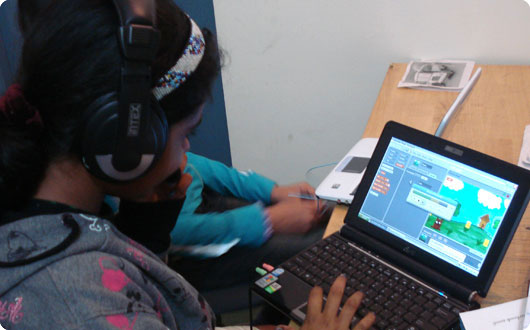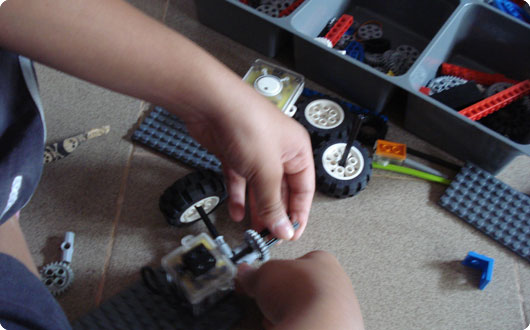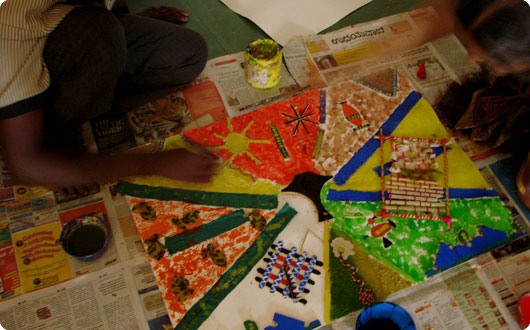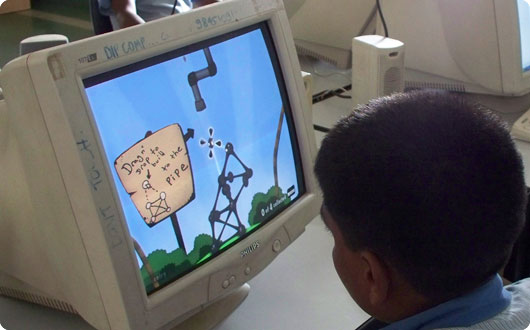
Borneo Project_step1 - Conducted 10 days camp with the std.6 kids from Mallya Aditi International School. The kids explored the Borneo Story which explains food networks and interdependency.
Above are the drawings created by the each child. Every child discussed their ideas and vision.
Scratch is a programming software developed by MIT (Boston). Kids used this Scratch to create Story-Games.
All the work done by the kids are uploaded on the Scratch website.
scratch.mit.edu/galleries/view/67284

Borneo Project_step2 - The process invovled deeply engaging with the story by role-plays and then stroy-boarding every aspect of their Story-Game. The next step involved understanding the Scratch Progamming.
The kids drew each character seperately which they had to animate and each background seperately. They scanned their own images.
All the work done by the kids are uploaded on the Scratch website.
scratch.mit.edu/galleries/view/67284

Borneo Project_step3 - After scanning the kids explored all the concepts and blocks on Scratch. They de-bugged every code and finally made their Story-Games on their individual laptops.
All the work done by the kids are uploaded on the Scratch website.
scratch.mit.edu/galleries/view/67284

Borneo Project_step4 - kids explored various sounds and recorded their own sounds. They programmed the sounds in Scratch.
All the work done by the kids are uploaded on the Scratch website.
scratch.mit.edu/galleries/view/67284

Borneo Project_step5 - The final Presentation was made to everyone in the class, including the facilitators.
The kids learnt a lot about Maths, logical thinking, story-boarding, sound recording, game strategies and programming.
All the work done by the kids are uploaded on the Scratch website.
scratch.mit.edu/galleries/view/67284

PlayZone_step1 - As part of PlayZone activity we conducted workshops for Std.6 kids from Mallya Aditi International School, Bangalore.
The kids created and learned about basic structures (gears, motions, balance etc.)
The workshop was held twice a week and the kids were exposed to basic sensor technology (light, sound, resistance etc.)

PlayZone_step2 - Kids individually constructed their own vehicles and iterated them over and over again till they got their final products.

PlayZone_step3 - The kids programmed their sensors on the computers using Pico-Crickets.
Pico-Crickets are sensor technology developed by MIT (Boston) and Lego.

PlayZone_step4 - The kids finally created their own vehicles and learnt a lot on constructions, basic physics and use of sensors to drive their cars.

Portfolio Making_step1 - Portfolio making was two and half months of hard-work put together by three cognitively challeged kids from the urban slums and myslef with a facilitator.
The kids had done work with local crafts material and had to showcase their work in the form of a portfolio.
The process followed was very intense and elaborate. The kids were asked to gather all their work and tag it or name it.

Portfolio Making_step2 - They then catagorised various types of craft they delt with. Each product was named and a list of items were drawn seperately.
The chart would constantly undergo changes and iterations.

Portfolio Making_step3 - The kids learnt photography in the process as they had to shoot their products with proper lighting and props.
This was a very difficult process as the kids had no control over the camera, but they all learnt and mastered the art.

Portfolio Making_step4 - The portfolio was in the form of a book, so it was inportant for them to prototype and explore book binding.
The kids learnt how to bind a book, measure using a ruler, not to fold the papers, be neat in their actions while pasting, etc.
They made 3-4 rough books before heading for the final prototype of the book.

Portfolio Making_step5 - They wrote their discriptions about each product in a given template and the script was written in Kannada (local language).
Towards the end of the process the kids developed beautiful handwritting with less spelling errors.

Portfolio Making_step6 - They created their own design for their cover and back page of the book.
The process was run by me and the material chosen were related to the products they had generated. The final collage was shot and edited on photoshop.

Portfolio Making_step7 - Before going to the printers the kids made a fantastic book by hand with no binding errors.
The final editing of the book was done by me and the final books were printed in good printing machines.

Forest World Project_step1 - Collaboratively conducted a summer camp with children from urban slums.
The were introduced to a brief and were asked to draw and imagine the stories. They did a role-play of their invented characters.
The process was elaborate and Scratch software was used to programme Story-Games as the final outcome.
Scratch is a progamming software designed and developed By MIT(Boston)
All the kids work was finally uploaded on the Scratch website.
scratch.mit.edu/galleries/view/50414

Forest Worls Project_step2 - The kids imagined their own characters and painted them. They also created rough story-boards and painted their backgrounds seperately.
All the kids work was finally uploaded on the Scratch website.
scratch.mit.edu/galleries/view/50414

Forest World Project_step3 - These kids are from urban slums from banaglore, so to introduce them to gaming we allowed them to play various types of games on computers.
All the kids work was finally uploaded on the Scratch website.
scratch.mit.edu/galleries/view/50414

Forest World Project_step4 - The kids discussed their ideas and story-games with all of us and scanned allthe required images.
They marked their backgrounds according to various scenes and activity.
All the kids work was finally uploaded on the Scratch website.
scratch.mit.edu/galleries/view/50414

Forest World Project_step5 - The kids used their own photographs to illustrate the story and the game.
They set their own backgrounds and marked various positions.
All the kids work was finally uploaded on the Scratch website.
scratch.mit.edu/galleries/view/50414

Forest World Project_step6 - Their was an extensive process followed to make them understamding programming on Scratch.
They de-bugged their own codes and understood logical methods of making a game and a story.
All the kids work was finally uploaded on the Scratch website.
scratch.mit.edu/galleries/view/50414

Forest World Project_step7 - Finally, the kids programmed the entire story-game on scartch.
They understood various aspects of game and story making. They learnt lots about Maths, story-boarding, logical thinking, photography, programming and English language in the process.
All the kids work was finally uploaded on the Scratch website.
scratch.mit.edu/galleries/view/50414

Insect Installation_step1 - This workshop was a part of the summer camp 2008. kids from urban slums were initially given toys to play, especiallly the toys that had lot of mechanics invovled (sound, motion, button, sensors etc.)
They were asked to anaylse and imagine the functionality of the toy. They sketched the functionalities with utmost details.

Insect Installation_step2 - The kids were then asked to replicate their designs into working models using Lego kits, Mechanics and K-nex.
They understood lots of physical mechanics while building the models.
Later they were asked to analyse the motions of insects and they constructed models using the same tools as mentioned above.

Insect Installation_step3 - On one side the kids used the Lego kits and tools to understand the physics and on the other side they actually started prototyping their own insects using paper and wood, keeping in mind the same functionalities and joineries.

Insect Installation_step4 - The kids created their own insects using waste paper, wood and other recycle materials.

Insect Installation_step5

Insect installation_step6 - The kids finally created their insects with motions and other realted characteristic. They created an installation by putting all their insects in their own edible garden (that they develop and maintain).

Insect Installation_step7 - The kids created their insects and programmed on the computer using Pico Cricket (sensor techonlogy) to give sound effects and behaviours to their insects.
The Pico Cricket units were then plugged on to the insects.

Nokia N810 (MAIS)_step1 - Collabortaed with MIT(Boston) and Nokia N810 team to make the Scratch programme working on the N810 device.
Conducted a workshop with the Mallya Aditi International School (Bangalore) kids to user test the programme and the device.
Six kids were given individual device to see how they perform with the device.
The results were recorded and an analytical report was submitted to Nokia (Helsinki) in the form of a book.

Nokia N810 (MAIS)_step2





Aata Paata Horaata (Play-Learn-Revolutionize)_1 - Aata Paata Horaata is a system comprising of face-to-face and virtual interactive learning spaces. The design was driven by the need for after-school safe havens (where play and learning reinforce each other) for children from urban slums. The project was presented at the Scratch@MIT Conference (MIT, Boston), to Microsoft (Seattle) and at the Quest Alliance 2008 Conference (Bangalore, India).
The paper is here: http://www.designingforchildren.net/papers/g-narayanan-designingforchildren.pdf

Aata Paata Horaata (Play-Learn-Revolutionize)_2 - Aata Paata Horaata is a system comprising of face-to-face and virtual interactive learning spaces. The design was driven by the need for after-school safe havens (where play and learning reinforce each other) for children from urban slums. The project was presented at the Scratch@MIT Conference (MIT, Boston), to Microsoft (Seattle) and at the Quest Alliance 2008 Conference (Bangalore, India).
The paper is here: http://www.designingforchildren.net/papers/g-narayanan-designingforchildren.pdf

Aata Paata Horaata (Play-Learn-Revolutionize)_3 - Aata Paata Horaata is a system comprising of face-to-face and virtual interactive learning spaces. The design was driven by the need for after-school safe havens (where play and learning reinforce each other) for children from urban slums. The project was presented at the Scratch@MIT Conference (MIT, Boston), to Microsoft (Seattle) and at the Quest Alliance 2008 Conference (Bangalore, India).
The paper is here: http://www.designingforchildren.net/papers/g-narayanan-designingforchildren.pdf

Aata Paata Horaata (Play-Learn-Revolutionize)_4 - Aata Paata Horaata is a system comprising of face-to-face and virtual interactive learning spaces. The design was driven by the need for after-school safe havens (where play and learning reinforce each other) for children from urban slums. The project was presented at the Scratch@MIT Conference (MIT, Boston), to Microsoft (Seattle) and at the Quest Alliance 2008 Conference (Bangalore, India).
The paper is here: http://www.designingforchildren.net/papers/g-narayanan-designingforchildren.pdf

Aata Paata Horaata (Play-Learn-Revolutionize)_5 - Aata Paata Horaata is a system comprising of face-to-face and virtual interactive learning spaces. The design was driven by the need for after-school safe havens (where play and learning reinforce each other) for children from urban slums. The project was presented at the Scratch@MIT Conference (MIT, Boston), to Microsoft (Seattle) and at the Quest Alliance 2008 Conference (Bangalore, India).
The paper is here: http://www.designingforchildren.net/papers/g-narayanan-designingforchildren.pdf

Aata Paata Horaata (Play-Learn-Revolutionize)_6 - Aata Paata Horaata is a system comprising of face-to-face and virtual interactive learning spaces. The design was driven by the need for after-school safe havens (where play and learning reinforce each other) for children from urban slums. The project was presented at the Scratch@MIT Conference (MIT, Boston), to Microsoft (Seattle) and at the Quest Alliance 2008 Conference (Bangalore, India).
The paper is here: http://www.designingforchildren.net/papers/g-narayanan-designingforchildren.pdf

Aata Paata Horaata Concept_1 - Aata Paata Horaata brands were individually conceptualized and modelled into a system design. Each of these systems and concepts are diagrammatically explained. The concepts are being tested out in various workshops on a regular basis with children from Drishya as well as the Mallya Aditi International School, Bangalore, India.
The illustration for all the concepts were visualised and created by me.

Aata Paata Horaata Concept_2 - Aata Paata Horaata brands were individually conceptualized and modelled into a system design. Each of these systems and concepts are diagrammatically explained. The concepts are being tested out in various workshops on a regular basis with children from Drishya as well as the Mallya Aditi International School, Bangalore, India.
The illustration for all the concepts were visualised and created by me.

Aata Paata Horaata Concept_3 - Aata Paata Horaata brands were individually conceptualized and modelled into a system design. Each of these systems and concepts are diagrammatically explained. The concepts are being tested out in various workshops on a regular basis with children from Drishya as well as the Mallya Aditi International School, Bangalore, India.
The illustration for all the concepts were visualised and created by me.

Aata Paata Horaata Concept_4 - Aata Paata Horaata brands were individually conceptualized and modelled into a system design. Each of these systems and concepts are diagrammatically explained. The concepts are being tested out in various workshops on a regular basis with children from Drishya as well as the Mallya Aditi International School, Bangalore, India.
The illustration for all the concepts were visualised and created by me.

Aata Paata Horaata Concept_5 - Aata Paata Horaata brands were individually conceptualized and modelled into a system design. Each of these systems and concepts are diagrammatically explained. The concepts are being tested out in various workshops on a regular basis with children from Drishya as well as the Mallya Aditi International School, Bangalore, India.
The illustration for all the concepts were visualised and created by me.

Aata Paata Horaata Concept_6 - Aata Paata Horaata brands were individually conceptualized and modelled into a system design. Each of these systems and concepts are diagrammatically explained. The concepts are being tested out in various workshops on a regular basis with children from Drishya as well as the Mallya Aditi International School, Bangalore, India.
The illustration for all the concepts were visualised and created by me.

Aata Paata Horaata Concept_7 - Aata Paata Horaata brands were individually conceptualized and modelled into a system design. Each of these systems and concepts are diagrammatically explained. The concepts are being tested out in various workshops on a regular basis with children from Drishya as well as the Mallya Aditi International School, Bangalore, India.
The illustration for all the concepts were visualised and created by me.

Sense-Non_1 - Sense-Non, a project dealing with non-linear ways and spaces of learning. How can technology be used to leverage science education? Can an experience be crafted that could facillitate future learning and understanding of science?
Final year thesis carried out under the guidance of Geetha Narayanan (Founder-Director, Srishti School of Art, Design and Technology, Bangalore, India).

Sense-Non_2 - Sense-Non, a project dealing with non-linear ways and spaces of learning. How can technology be used to leverage science education? Can an experience be crafted that could facillitate future learning and understanding of science?
Final year thesis carried out under the guidance of Geetha Narayanan (Founder-Director, Srishti School of Art, Design and Technology, Bangalore, India).

Sense-Non_3 - Sense-Non, a project dealing with non-linear ways and spaces of learning. How can technology be used to leverage science education? Can an experience be crafted that could facillitate future learning and understanding of science?
Final year thesis carried out under the guidance of Geetha Narayanan (Founder-Director, Srishti School of Art, Design and Technology, Bangalore, India).

Sense-Non_4 - Sense-Non, a project dealing with non-linear ways and spaces of learning. How can technology be used to leverage science education? Can an experience be crafted that could facillitate future learning and understanding of science?
Final year thesis carried out under the guidance of Geetha Narayanan (Founder-Director, Srishti School of Art, Design and Technology, Bangalore, India).

Sense-Non_5 - Sense-Non, a project dealing with non-linear ways and spaces of learning. How can technology be used to leverage science education? Can an experience be crafted that could facillitate future learning and understanding of science?
Final year thesis carried out under the guidance of Geetha Narayanan (Founder-Director, Srishti School of Art, Design and Technology, Bangalore, India).

Sense-Non_6 - Sense-Non, a project dealing with non-linear ways and spaces of learning. How can technology be used to leverage science education? Can an experience be crafted that could facillitate future learning and understanding of science?
Final year thesis carried out under the guidance of Geetha Narayanan (Founder-Director, Srishti School of Art, Design and Technology, Bangalore, India).

Sense-Non_7 - Sense-Non, a project dealing with non-linear ways and spaces of learning. How can technology be used to leverage science education? Can an experience be crafted that could facillitate future learning and understanding of science?
Final year thesis carried out under the guidance of Geetha Narayanan (Founder-Director, Srishti School of Art, Design and Technology, Bangalore, India).
gLike